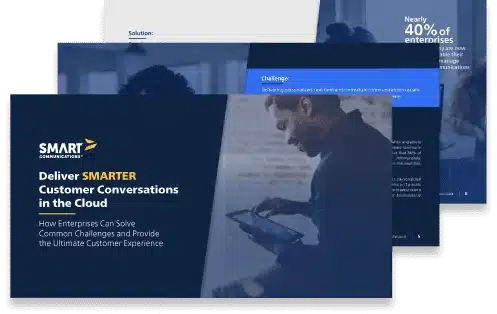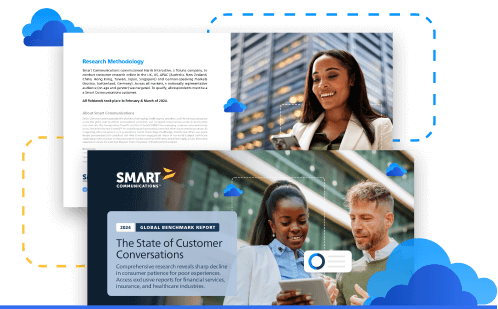The New Rules of Digital Transformation Strategy
By: Neil Greathead, Chief Customer Officer at Smart Communications
Digital transformation strategies have been hot topics for quite some time, and most businesses have been making steady progress to achieve their digital goals. That is until the pandemic struck. Suddenly, plans became accelerated, and many businesses discovered just how much progress could be made in a short period of time with sustained focus and effort. As customer expectations continue to rise, enterprises around the world need to double down on these strategic digital efforts to ensure the end-to-end experience is better than ever.
In this post, we share exclusive insights into the new rules of digital transformation strategy, with help from Leroy McCarty, VP of Operations at Forrest T. Jones & Company, a leading Smart Communications customer. Forrest T. Jones leverages both SmartCOMMTM and SmartIQTM as the foundation for its organization-wide digital modernization journey – exceeding customer expectations at every step of their journey.
Rule 1: You must define a long-term vision rooted in meeting customer needs and expectations.
Creating and executing on a digital transformation strategy is a journey, and without a clear destination in mind, it’s easy to get off track. Take the time to clearly define what the digital future looks like for your organization, based on your customers’ needs and expectations.
“We had a vision for the future, for the modernization of really everything we did, and digitization was a key part of that strategy…we made sure that we were aligned with expectations of the customer for the journey that they expected to take.” – Leroy McCarty, Forrest T. Jones & Company
This requires listening carefully and keeping an open mind, as their feedback might be different from what you expect. You can also leverage industry research, like Smart Communications’ benchmark study, which makes it clear that:
- 86% of consumers prefer digital technology over other forms of communications
- 57% of consumers will abandon an interaction if a company has an inefficient process for collecting information
- 63% of businesses think they are delivering excellent or very good communications, but only 51% of consumers agree
Rule 2: You must break down internal silos to create a truly customer-centered organization.
With your digital strategy in place, you can now focus on the “how”: what do you need to do to achieve that vision in the timeframe you’ve set for yourself? As you get to work, it’s important to think holistically. You need both your back-end and front-end processes and touchpoints in between working in harmony with each other to achieve your goals. The objective here is synergy: whatever technology you decide to implement for back-end data processing and integration handling should work seamlessly with a front-end experience that customers will love.
“Smart Communications has come in to help us with our digital strategy and to respond to the new expectations of the market, giving us the front-end and back-end to our entire lifecycle of an application.” – Leroy McCarty, Forrest T. Jones & Company
The best part? You don’t have to choose multiple vendors to follow this rule. It’s actually better if you don’t, because the simpler your digital transformation strategy is, the more likely you are to achieve it. That’s why organizations like Forrest T. Jones choose Smart Communications for both their cloud-based Customer Communications Management (CCM) and dynamic digital forms technologies. This one-two punch streamlines your approach and empowers you to achieve your vision faster.
Rule 3: Your digital transformation strategy must enable better omnichannel experiences at scale.
Consumers these days are practically swimming in a sea of digital devices. And whether it’s related to financial services, healthcare, insurance or other critical industries, consumers want to get things done from whatever device they happen to be holding at the time. Practical concerns like making sure customers only have to enter their information once (or even better, have forms pre-filled with the information you already have) are where the digital transformation rubber meets the road.
“Where SmartIQ has helped us tremendously is allowing us to take anything that we need to get from a customer and put it in front of them wherever they are, whatever time of day, whatever device they’re on, and help them do business with us.” – Leroy McCarty, Forrest T. Jones & Company
The challenge to getting this right is not just with one interaction in one place (say, your website) at one time, but everywhere a customer chooses to interact with you. Plus, customers should be able to initiate a digital interaction on one device, and pick up where they left off on another. Next-generation digital forms offer significant advantages over paper-based or static forms, creating an omnichannel experience that is personalized, collaborative and automated. Technologies like SmartIQ provide customers with fantastic experiences on the front-end while requiring minimal IT resources on the back-end – a win-win for everyone.
The Time for Digital Transformation is Now
Transformation can be daunting because there’s no time to waste in creating the best digital customer experience. Fortunately, as organizations like Forrest T. Jones & Company have learned, the right partner can make all the difference.
“We were fortunate in that we had a pretty clear vision for what we thought the future was going to hold, and so we aligned ourselves with Smart Communications to be able to deliver on that vision.” – Leroy McCarty, Forrest T. Jones & Company
To learn more about how Forrest T. Jones & Company use Smart Communications to transform their customer conversations, check out the video below.



